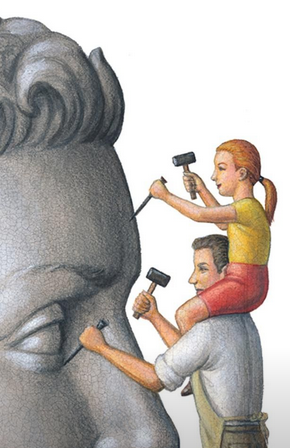 For Father’s Day The Wall Street Journal published a roundup by Lee Siegel on “Portrait of the Artist as a Great Father; The cliché about famous creative types is that they’re self-obsessed and withdrawn. Less familiar—but more plentiful—are the stories of paternal affection that flows from artistic bounty.”
For Father’s Day The Wall Street Journal published a roundup by Lee Siegel on “Portrait of the Artist as a Great Father; The cliché about famous creative types is that they’re self-obsessed and withdrawn. Less familiar—but more plentiful—are the stories of paternal affection that flows from artistic bounty.”
In it, Siegel rebuts the cliché of the “bad artist father: icy, hurtful, self-obsessed. Withdrawn into impenetrable creative isolation—so the stereotype goes—these parental monsters punish any attempted breach of their solitude by inflicting lifelong trauma on those closest to them.”
Siegel writes, “Here is David Updike, son of the novelist John, remembering that when he and his siblings ‘appeared unannounced, in [their father’s] office—on the second floor of a building he shared with a dentist, accountants and the Dolphin Restaurant—he always seemed happy and amused to see us, stopped typing to talk and dole out some money for movies. But as soon as we were out the door, we could hear the typing resume, clattering with us down the stairs.”
Among the other examples of creative fatherly love provided in the story is Henrik Ibsen. “So devoted was he to his only child, Sigurd, that when the boy was told, to his despair, that law school in Norway would not accept credits from the German gymnasium he had attended, his angry father moved the family to Rome, in part so that his son could complete his law degree there. Sigurd later became Norway’s prime minister.”
Tenderness is cited in Bernard Malamud, whose letter to a friend reflects how enchanted he was by his seven-year-old child: “Yesterday . . . I took Janna to the bank of a river she likes. She waded in the cold water, scooped up minnows with a strainer and learned how to skim flat rocks across the water . . . . As I sat on a log by the river, watching her yesterday, it was as if I were reading a long poem, every line full of beauty.”
There’s a bit of romanticizing going on in the article, as Siegel says, “There seems to be some mystical bond, especially between artist-fathers and their artist children, something particularly profound in sharing the gift of creativity with the parent who helped to create you.” A fuller study with more than single examples per author would no doubt reveal a more complex “portrait.” But what kind of Father’s Day reading would that make?
Read the full article.
